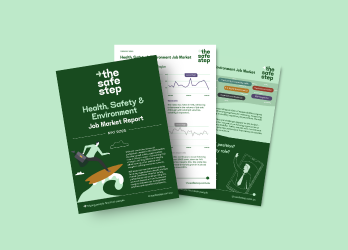Health and Safety trends in 2024
Page Published Date:
January 30, 2024
What will the year ahead look like for the Health, Safety & Environment (HSE) profession in Australia? We break out the crystal ball and offer some observations and predictions for 2024.
Read on to understand some of the drivers of the HSE talent market and broad trends that will influence levels of demand in 2024.

Health & Safety jobs remain resilient
Whilst there is some softening in Australia’s general employment market, Health, Safety and Environment (HSE) career prospects will remain particularly resilient.
Off the back of record-high demand in 2023, the HSE job market has already entered 2024 with strong momentum.
Typically recruitment is quiet in January, but not so this year. Employers have begun their hiring processes much earlier than usual, with notably high demand at the senior levels of the HSE profession.
Whilst not completely immune to economic turbulence, signs point to an optimistic outlook for those looking to advance their career in 2024.
‘Use-by dates’ create leadership churn
During the COVID period, the pace of churn at the senior/leader level of the HSE profession was put on pause. As a result, the average tenure of leaders has increased. Many have now reached, or exceeded, their own ‘use-by date’.
Self-reflection is normal at the start of the calendar year, but this is particularly amplified this year. It’s clear, that for many senior HSE professionals that 2024 will be a year to be refreshed by taking on different challenges in a new environment.
The increase in leadership turnover will inevitably have a cascade effect, impacting HSE functions at every level. Shifts in 2024 may introduce new perspectives and strategies in how HSE services are delivered. It could also result from, or lead to, a formal directive for organisational change, reflecting a broader transformation in the company's approach to health, safety, wellbeing and environment.
We go back to basics
Hand-in-hand with leadership changes, there has been a noticeable trend of organisations adopting a ‘Back to Basics’ agenda. What’s driving this? Potentially a sense that a reset is needed.
HSE leaders have been tasked with complicated agendas over recent years such as managing psychosocial risk in the workplace, and developing Environmental, Social and Governance (ESG) metrics which are increasingly linked to performance, not just compliance.
The responsibility to target, manage, measure and report about psychosocial risk and sustainability performance to stakeholders - including company boards, external organisations, as well as current and potential employees - has been challenging.
Has this shift led to a loss of focus on core fundamentals? Not really. However, there is a sense in some organisations that they need to re-focus on core services.
Legislation & reputation a focus
Legislative changes continue to wash through Australia’s business landscape, necessitating focus from HSE professionals.
A perfect example is the National Heavy Regulators Chain of Responsibility (CoR), a key part of the Heavy Vehicle National Law (HVNL), which stipulates: “Everyone who works with heavy vehicles - from the business that employs a driver or owns a vehicle, to the business that sends or receives goods, is accountable for the safety of the heavy vehicle, its driver, and its load throughout the journey.” The laws broader definition of responsibility extends to corporate entities, directors, partners and managers, who are all accountable for the actions of people under their control.
In addition, discussions around psychosocial safety, respect at work, crystalline silica dust safety will also continue to loom large.
New legislation, combined with a raft of other risks and evolving community expectations, mean that stakeholders and most notably Boards, will be intensely focused on potential reputation damage in 2024.
The E agenda grows
According to The Safe Step’s latest HSE Job Opportunities Index, demand for Environment specialist expertise rose 34.6% in the 2-years to October 2023.
Clearly there is an increase in the ‘E’ element of HSE. Having said that, the challenge for 2024 will be meeting increased demand with Talent Supply.
We have found that many Environment roles are particularly technical, but also require a range of expertise across a broad range of areas. Sourcing broad generalists in the Environmental space is especially challenging and without some programs to develop skills and expertise, demand will be high on an ongoing basis.
AI creates upheaval & opportunity
Under headings like “Is AI coming for your job?”, the media is rife with stories and speculation on the impacts of artificial intelligence in the year ahead. It has significant disruptive potential for many high-skilled jobs as well as clear benefits in productivity and salaries for some occupations.
The International Monetary Fund’s CEO Kristalina Georgieva noted that “in advanced economies, about 60 per cent of jobs may be impacted by AI” but that 50% of these would benefit from enhanced productivity. The UK Financial Times ran a survey of global companies and indicated that admin heavy sectors such as Banking and Insurance will of course be at the forefront of AI-related changes. Media, logistics and other sectors were also mentioned as sectors likely to be impacted.
So, what is the likely impact/benefit for HSE roles? Time will tell but already AI is being used to analyse large chunks of historical data related to such things as incidents, accidents, and near misses to identify patterns and categorise safety risks allowing for proactive measures to be introduced.
Where there will be friction is the overuse of workplace monitoring. Artificial intelligence pundits say that AI can monitor the work environment and detect hazardous situations in real-time and identify unsafe employee behaviour. This might be tricky to navigate in relation to camera systems with image recognition capabilities being used to ‘spy’ on team members. Personal data collected by wearable devices also has the potential to be contentious. Ethics and responsible safety innovation will be important to consider in 2024.
HSE leaders and professionals will be confronted with a range of challenges balancing workplace rights and privacy with apparent technology benefits using AI.
In summary
Across the board, HSE functions are primed for some timely changes. Between leadership churn, legislation changes, the increased impact of AI and technology, the continued rise of environment concerns and roles with a large E component among a range of other agenda’s, there seems to be plenty of changes afoot in 2024 in HSE.
Please reach out to anyone in the team at The Safe Step or for a further discussion, please contact us on: info@thesafestep.com.au
How can we help?
2024 will no doubt be an interesting year for workplace health and safety functions. Expected changes are likely to affect capability and employment requirements.
If you are looking to hire a workplace health and safety professional or are searching for a new HSE role please reach out to Craig, your Safe Step consultant or contact us to speak to a team member in your region for a further discussion.




